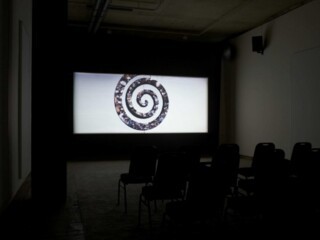At Frith Street
Mark Blacklock
Tacita Dean’s film JG, showing at Frith Street Gallery until 26 October, was inspired by a correspondence with J.G. Ballard shortly before his death from cancer in 2009. Dean was interested in the connections between Ballard’s short story ‘The Voices of Time’ (1960) and Robert Smithson’s Spiral Jetty (1970), a 1500-foot earthwork built into the Great Salt Lake in Utah. Ballard urged Dean to ‘treat it as a mystery that your film will solve’. He sent her a piece he’d written on Smithson for a gallery, ‘Robert Smithson as Cargo Cultist’ (1997), and briefed her on his reading of Spiral Jetty:
Firstly, why a spiral jetty? What conceivable cargo would require a spiral jetty for its loading/unloading? Either Smithson was serious, or the jetty is just a 10,000-ton doodle with no particular significance. I prefer to think that Smithson was serious. My guess is that the cargo was a clock, of a very special kind. In their way, all clocks are labyrinths, and can be risky to enter.
Ballard praised Dean’s ‘masterpiece, the revolving TV tower restaurant, another labyrinth people enter at their own peril. I’ve never eaten at a revolving restaurant – I fear I’d have a nervous breakdown.’ Dean’s film Fernsehturm (2001) was shot at the top of the television tower on Alexanderplatz in Berlin. If the revolving restaurant is a labyrinth, it’s also a clock (Marina Warner has called Dean ‘one of the most delicate time machinists of all’).
The correspondence – held at the British Library, which lets you access only one side at a time so you have to read it out of order – also loops back on itself. Dean describes trying but failing to find Spiral Jetty in 1997, at around the same time as she read ‘The Voices of Time’: ‘The aura of the place affected me deeply: the redness of the lake, the fact that all the weed was covered in a shell of salt, the scruffy no-time of it.’
She told Ballard she thought Spiral Jetty was inspired by ‘The Voices of Time’. One of the characters in the story lives in ‘an old abstract summer house... a seven-storey folly... in the form of a spiralling concrete ribbon that wound around itself like an insane serpent... a geometric model of √-1’. Another, Powers, builds a huge concrete mandala, ‘like a cosmic clock’, in the middle of a salt lake: ‘Smithson had a copy of your story before he built the jetty. All his books have been filed along with the dates they entered his library. So the connection was made.’
Dean told Ballard that the Dia Art Foundation in New York had plans to restore Spiral Jetty. He was unimpressed:
For some reason I hate the idea of the jetty being built up – it will change its character – knowing the Americans, it will be all smooth and tidy, + look like a motorway off-ramp – is it necessary? This lake has been sinking and rising for millions of years.
On 28 February 2008, in reply to a letter in which Ballard had joked that as part of his treatment for cancer he now had to take more steroids than a bodybuilder, Dean wrote: ‘Thank you for being such an important figure in my life, odd as it may seem considering the work I make and how far it might appear from yours.’ The word ‘odd’ has been smudged – by a drop of water? A tear? If so,whose? It doesn’t much matter (though ‘genetic’ criticism may one day have an answer).
At the end of 'The Voices of Time', Powers, standing in the centre of his mandala, feels the 'massive magnetic pull' of a 'vast course of time':
Around him the outlines of the hills and the lake had faded, but the image of the mandala, like a cosmic clock, remained fixed before his eyes, illuminating the broad surface of the stream.Watching it constantly, he felt his body gradually dissolving, its physical dimensions melting into the vast continuum of the current.
